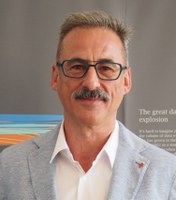Catherine, why does the EEA work on health and the environment? What are the biggest risks to our wellbeing?
Human health and ecosystem health are inextricably linked. Our bodies need clean air, water and food every day to function. We thrive as people and as communities by spending time in nature, exercising, socialising and relaxing. At the same time, when we live, work, go to school or play in polluted environments, both our bodies and our minds suffer. Protecting nature is not about protecting the planet. It is about securing our own health and well-being, and that of our children. Preventing pollution is a public health measure.
The biggest immediate risks to health are air pollution and noise, especially in cities. Over the long term, climate change poses an existential threat to our way of life. This includes immediate loss of life due to heat waves, forest fires and floods, as well as longer terms threats to food production from changing weather patterns. We also see shifts in the distribution of infectious diseases as the insect vectors that carry those diseases move north with the warming climate. We also know that certain chemicals are dangerous to health.
What work has the EEA undertaken so far in this area?
We are working to better understand how our environment influences our health and well-being. We gather evidence on how people across Europe are exposed to a range of environmental risks, including air pollution, noise, climate change and chemicals. Our recent report Healthy environment, healthy lives: how the environment influences health and well-being in Europe — European Environment Agency pulls together the latest evidence and assesses the impact on health. The World Health Organization estimates that in Europe, one in eight deaths result from environmental pollution. These deaths are preventable and could be avoided through efforts to improve environmental quality.
We also explore how environmental risks are distributed across society and find that the most vulnerable people in our society are hardest hit by environmental stressors. Socially deprived communities are exposed to a higher burden of pollution. Poorer people, children, the elderly and people with ill health are more negatively affected than others by environmental health hazards. This unequal distribution of risk exacerbates existing health inequities in Europe.
On the positive side, we also look at the benefits that nature provides. In particular, the vast majority of people in Europe have access to high quality drinking water, while European bathing waters are of excellent quality and provide opportunities for exercise and recreation.
How does the EEA’s work support the European Green Deal?
The EEA’s work on environment and health puts together the available evidence on how health across Europe is impacted by pollution, climate change and ecosystem degradation. Our recent report The European environment — state and outlook 2020 (SOER 2020) describes how our current way of life, in terms of what we produce and consume, our energy use, our mobility choices and our food system, drives environmental degradation. This knowledge base supports efforts to change that dynamic through a transition under the European Green Deal.
Alberto, why is air quality such an important factor to the health of Europeans?
Air pollution is considered the single largest environmental risk in Europe. According to our latest estimates, exposure to fine particles (the pollutant with most serious impacts on human health) caused more than 400 000 preventable deaths in Europe in 2018. Those deaths were mainly due to cardiovascular and respiratory diseases and cancer. But apart from these very serious diseases, there is growing evidence that exposure to air pollution is associated with other impacts on health. Among them, we can mention new-onset type 2 diabetes, systemic inflammation or mental disorders such as Alzheimer’s disease and dementia.
Air pollution also affects the environment, for instance reducing biodiversity in certain ecosystems and affecting the growth of vegetation and crops. It also impacts on the built environment, damaging for example our cultural heritage.
How has the situation improved over the last few years? What are the problems that still need to be tackled?
The implementation of EU, national and local policies and measures has led to a reduction in the emissions of all air pollutants, a reduction of the population’s exposure resulting in fewer health impacts.
Emissions differ according to pollutants and economic sectors. For instance, agriculture and the use of fuels for residential heating are two of the sectors with greatest potential for further reduction in emissions. Another problem that still exists, despite steady reductions is that we still suffer an unbearable burden in terms of preventable deaths. The increasing influence of climate change in the production of some pollutants like ozone is also a concern as is the need to look for synergies in the policies fighting both air pollution and climate change.
Eulalia, why is noise pollution is often overlooked and what is the EEA doing in this area?
Many people don’t realise that noise pollution is an important problem. It impacts our health. When we think about noise affecting our health, we think about going to a concert or being close to a loud machine which damages our hearing. However, what people don't realise is that constant levels of noise from traffic, for instance, can cause other effects that are not related to hearing damage; and these are serious such as ischaemic heart disease, high blood pressure, obesity, diabetes etc. Authorities recognise that noise is a problem, that is why we have a European Directive on Environmental noise since 2002 and we have new guidelines from the WHO. The problem is more about taking action and having the financial means to do so. It is a difficult issue because, for instance cities and outskirts of cities become more and more populated and there is more demand for mobility.
The Agency’s work on noise focusses on assessing the impact of noise pollution at the European level. We evaluate the impact of noise exposure on the health of the European population, based on the latest European data.
What are the main findings of your briefing? What makes it different from the EEA report released earlier this year?
The EEA report Environmental Noise in Europe was published in March. And now we are publishing a briefing that describes the health risks due to exposure to environmental noise in Europe. The briefing describes indicators that will be used to inform the development of future targets to reduce the health impacts of noise. In terms of specific health effects, we estimate that chronic exposure to noise contributes to 48 000 new cases of heart disease and 12 000 premature deaths every year in Europe. In addition, 22 million people suffer chronic high annoyance, and 6.5 million suffer chronic high sleep disturbance.
How do you all see work in your areas evolving in the years ahead?
We expect increased involvement of the EEA in these areas. We hope that the European Green Deal will be a game changer in Europe which will result in more awareness about environmental issues such as air and noise pollution and that will also trigger better policies.
In addition to the Green Deal, the World Health Organization has recently published environmental noise guidelines as is going to publish new air quality guidelines. We envisage that the publication of these guidelines will give further visibility to the problem of noise and air pollution.

Catherine Ganzleben
Head of group — Air pollution, environment and health

Alberto González
EEA air quality expert

Eulalia Peris
EEA noise pollution expert



Document Actions
Share with others